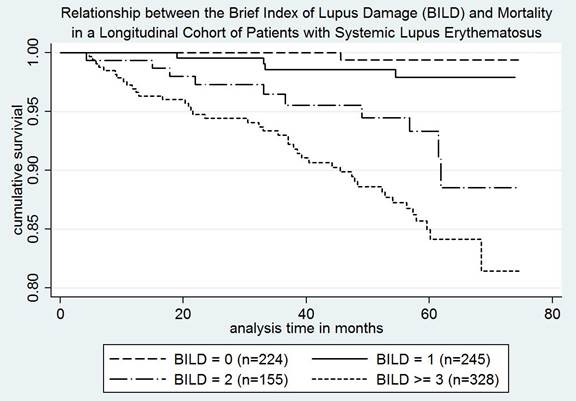Session Information
Session Type: Abstract Submissions (ACR)
The Brief Index of Lupus Damage as a Predictor of Mortality in a Cohort of Patients with Systemic Lupus Erythematosus
Background/Purpose: To examine whether a validated patient-reported measure of lupus damage, the Brief Index of Lupus Damage (BILD), is a predictor of mortality in a longitudinal cohort of patients with systemic lupus erythematosus (SLE).
Methods: Data were gathered from the UCSF Lupus Outcomes Study (LOS), an annual phone interview in which the BILD was administered beginning in 2007. We analyzed the initial BILD score for all participants. BILD scores were divided into 4 categories corresponding to 0, 1, 2, and ≥ 3 points (higher scores represent more damage). The number of deaths up to 75 months of follow-up was determined. Kaplan-Meier life table analysis was used to compare mortality rates by categories of the BILD. Using Cox proportional hazard models, multivariate analyses of possible predictors of mortality were performed. In addition to disease damage, predictors examined included a self-reported disease activity measure (Systemic Lupus Activity Questionnaire, SLAQ), non-white ethnicity, education beyond high school, gender, age, and disease duration.
Results: Among 952 subjects completing the BILD, the mean age was 49 years, 92% were female, 63% Caucasian, the mean disease duration was 16 years, and the median BILD score was 2 (range 0-13). During the follow-up period there were 57 deaths (6.0%). The mean follow-up time was 58 months (range 4-75). Kaplan-Meier analysis showed significantly higher mortality with increasing BILD scores (see figure). In Cox proportional hazards models adjusting for age, gender, disease duration, and SLAQ score, a BILD score of 2 (hazard ratio [HR]: 12.4; 95% confidence interval [CI]: 1.6-97.4), and a BILD score of ≥ 3 (HR: 21.4; 95% CI 2.9-159.2) were associated with higher risk of death over the follow-up period. Race, education, gender and SLE disease activity were not associated with increased mortality risk.
Conclusion: Independent of age, sex, race, disease duration and activity, a higher BILD score was a strong predictor of mortality in this cohort. Given the established relationship between SLE damage and mortality, the results provide further validation of this patient-reported damage index and support its usefulness in clinical research.
Disclosure:
S. Rush,
None;
L. Trupin,
None;
J. Yazdany,
None;
P. P. Katz,
None.
« Back to 2013 ACR/ARHP Annual Meeting
ACR Meeting Abstracts - https://acrabstracts.org/abstract/the-brief-index-of-lupus-damage-as-a-predictor-of-mortality-in-a-cohort-of-patients-with-systemic-lupus-erythematosus/

